Horses need a dentist too!
by Dr. Chantal Murack, DVM
Adult horses can have 36-44 teeth with the average tooth being 4 inches long. That’s a LOT of teeth! When a horse chews its food the lower jaw (mandible) actually moves in a circular pattern, unlike humans who chew their food with an up and down motion of the mandible. This circular motion is important to grind the food and make it digestible for the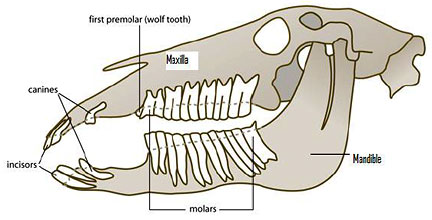 horse; however it also causes a very predictable pattern of wear on the surface of the cheek teeth, also called molars. Because the upper jaw (maxilla) is wider than the mandible, when the mandible moves it causes the inside of the upper cheek teeth and the outsides of the lower cheek teeth to wear down. As the inside of the upper teeth is getting worn down the outside of the same teeth is not getting worn down and continues to grow, which over time results in sharp points on the outside of the upper cheek teeth and the insides of the lower cheek teeth.
horse; however it also causes a very predictable pattern of wear on the surface of the cheek teeth, also called molars. Because the upper jaw (maxilla) is wider than the mandible, when the mandible moves it causes the inside of the upper cheek teeth and the outsides of the lower cheek teeth to wear down. As the inside of the upper teeth is getting worn down the outside of the same teeth is not getting worn down and continues to grow, which over time results in sharp points on the outside of the upper cheek teeth and the insides of the lower cheek teeth.
The amount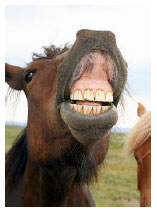 of time a horse spends chewing and the type of food that it chews (grass, hay, grain, supplements) dramatically affects the way the teeth wear and how quickly the sharp points form. Horses living in the wild spend over half of every day chewing and chew more fibrous diets than horses that are domesticated. These factors combine to make dental problems less common in wild horses. Additionally, wild horses don’t live as long as domesticated horses so they have less time to develop dental abnormalities. Some bad habits that a lot of stabled horses have, such as chewing on wooden fences and cribbing, also negatively impact how the teeth wear. When points on the teeth are very small they may not cause any obvious problems but as they get larger you may start to notice some things. Signs that your horse has a dental abnormality may include any of the following: resistance to take the bit, throwing the head when being ridden, dropping food when eating, spitting out large wads of hay, weight loss, facial swelling, and bad breath.
of time a horse spends chewing and the type of food that it chews (grass, hay, grain, supplements) dramatically affects the way the teeth wear and how quickly the sharp points form. Horses living in the wild spend over half of every day chewing and chew more fibrous diets than horses that are domesticated. These factors combine to make dental problems less common in wild horses. Additionally, wild horses don’t live as long as domesticated horses so they have less time to develop dental abnormalities. Some bad habits that a lot of stabled horses have, such as chewing on wooden fences and cribbing, also negatively impact how the teeth wear. When points on the teeth are very small they may not cause any obvious problems but as they get larger you may start to notice some things. Signs that your horse has a dental abnormality may include any of the following: resistance to take the bit, throwing the head when being ridden, dropping food when eating, spitting out large wads of hay, weight loss, facial swelling, and bad breath.
By the time you notice some of the above signs, the dental abnormalities may be severe. To prevent things from getting to this stage it is recommended that every horse have an annual dental evaluation. A yearly exam provides the opportunity to find problems when they are in the early stages and correct them before severe problems develop. Horses don’t have their full set of adult teeth until they are about 5 years old. Therefore, horses that are 2-5 years old may need more frequent dental care to keep up with all the changes occurring in their mouth during this time. 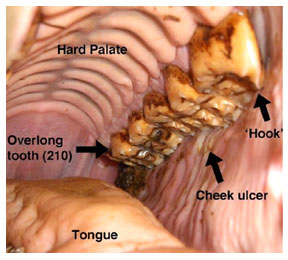
To examine your horse’s teeth your veterinarian will sedate your horse and put a large metal gadget, called a speculum, in their mouth. The speculum allows us to look and feel in their mouth without the risk of getting bitten. Once an examination of the cheek teeth has been performed, the cheek teeth will be “floated”. Floating is the term used to describe removing the sharp enamel points. There are two main categories of “floats”, hand floats and power floats. Hand floats are like long sharp files and have been around for a long time. Power floats are like a long handled electric drill with a sharp burr on the end and are a more recent development in equine dentistry. The main advantages of using a power float are that it doesn’t require as much physical strength to operate and you can finish the procedure much quicker.
Pictured to the right are the upper left cheek teeth of a horse prior to floating. As you can see in the picture the edges of the teeth that are against the cheek tissue are very sharp and have caused a small ulcer. There is also a hook on the first cheek tooth and one of the back cheek teeth has grown too long. These are all common findings during a routine yearly dental examination and can easily be corrected with appropriate floating.
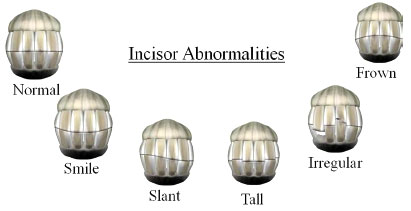 More severe problems include fractured teeth, wave mouth, step mouth, misaligned incisors, abscessed tooth roots, cavities, and periodontal (gum) infections. These severe problems can develop from a lack of proper dental care sometimes the structure of a horses mouths can predispose them to certain painful conditions.
More severe problems include fractured teeth, wave mouth, step mouth, misaligned incisors, abscessed tooth roots, cavities, and periodontal (gum) infections. These severe problems can develop from a lack of proper dental care sometimes the structure of a horses mouths can predispose them to certain painful conditions.
Equine dentistry has changed and advanced significantly over the past 10 years. Cavities and periodontal infections never used to be recognized or treated but as the equipment and diagnostic tools have advanced, veterinarians are spending more time looking in horses mouths and finding abnormalities we never knew were there before. Teeth with cavities that would have been pulled or left to rot in the past can now be treated and saved. And painful periodontal infections, which were not diagnosed when floating teeth first came about, can easily be recognized with the help of a mirror to look between all the teeth. As always, prevention and early diagnosis is less expensive and more effective than treatment once a problem has become severe. Proper dental care will help your horse live a longer more comfortable life. For more information on equine dentistry and to make a dental care plan for your horse please contact your regular veterinarian.
Dental Care for Dogs and Cats 101
We all know how important it is to brush our own teeth and keep our mouths clean, but how often do we think about the mouths of our pets? Cats and dogs have mouths very similar to our own and actually suffer from the same dental conditions that people do; in fact gum disease is th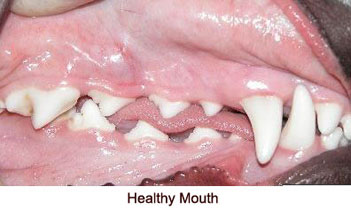 e most common disease diagnosed in cats and dogs. It’s so common that by the time 50% of cats and 80% of dogs have reached three years of age they have some level of periodontal (gum) disease. However unlike people, cats and dogs aren’t able to brush and care for their own teeth, they need our help to keep their mouths clean and healthy.
e most common disease diagnosed in cats and dogs. It’s so common that by the time 50% of cats and 80% of dogs have reached three years of age they have some level of periodontal (gum) disease. However unlike people, cats and dogs aren’t able to brush and care for their own teeth, they need our help to keep their mouths clean and healthy.

Ok, so that’s really gross but can’t I just not look? Not exactly… eventually the bacteria that build up on the teeth may cause your pet to have bad breath, bleeding, pain, trouble eating, and some teeth may even fall out. Even more worrisome than a lost tooth is the damage the bacteria can do in the rest of your pets body. Studies have shown that bacteria in the mouth can get into the blood stream and migrate to the kidneys, heart, or liver and cause severe damage there that may eventually lead to death.
The best way to keep your pets mouth healthy is prevention of dental disease and plaque buildup before it starts. Daily brushing is the most reliable way to keep bacteria from establishing a stronghold in your pets mouth, chewing on abrasive surfaces and certain diets can also help reduce bacteria load.
My pet won’t tolerate me brushing its teeth, is there anything else I can do to help keep his teeth and mouth healthy? If given enough time almost all pets eventually accept brushing, but forcing an animal to do something always carries a risk. There are lots of products on the market and in stores that claim to keep teeth clean and healthy, however not all of them are created equal, as a general rule if it sounds too good to be true it probably is. CET Dental Chews (http://www.virbacvet.com/products/detail/c.e.t.-enzymatic-oral-hygiene-chews-for-dogs/dental-health/chews) and Hill Prescription Food T/D (teeth diet) are two products that have proven results; when brushing isn’t an option these are the next best thing.
My dog has lots of toys that he chews on and plays with all the time, does that mean I don’t have to worry about his teeth? The answer here really is, it depends. Some toys do help remove plaque from teeth while others do not and can actually damage the teeth. Lots of dogs LOVE tennis balls but the abrasive outer surface often wears down the canine teeth and can lead to painful pulp exposure. If you have a ball loving dog, a smooth surface ball might be a better choice for their teeth. Hard nylon products can also be dangerous. These products are often so hard that aggressive chewing can lead to broken painful teeth and damaged gums, especially in puppies and small dogs.
My pet already has severe dental disease; can I fix it with daily brushing and a dental diet? Unfortunately no, once your pet has a significant amount of plaque built up on their teeth a professional dental cleaning by a veterinarian is required to restore oral health. To allow veterinarians to perform a full oral examination the use of anesthesia is needed in all pets. A dental includes a thorough history and visual exam, often with radiographs, and all abnormalities being charted. An ultrasonic scaler is then used to remove the plaque from all surfaces of the teeth and any teeth that are too unhealthy to be saved are carefully extracted (pulled). After scaling is complete, all the teeth are polished to remove any left-over plaque and to prevent future build up by smoothing out the tooth surface.
There you have it, the basics of dog and cat dental care. Brushing is best, start early and brush often. When brushing isn’t an option certain chews and foods can help reduce bacterial load. For specific recommendations for your pet and to find out what stage gum disease they may have, contacting your regular veterinarian is the best way to get reliable information.
Return to topics.